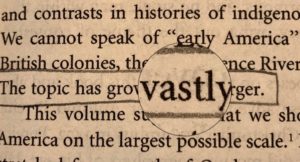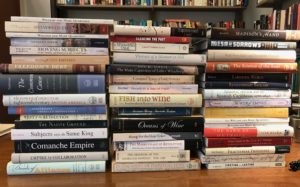
My marked copy of the Introduction to Contested Spaces of Early America ed. by Juliana Barr and Edward Countryman (U Penn Press, 2014)
In a 2006 essay for the American Historical Review, “Atlantic History: Definitions, Challenges, and Opportunities,” Alison Games encouraged historians to “leap into the ocean….[t]he water’s great.” More capacious even than Atlantic history, Vast Early America offers its own distinct set of challenges and opportunities. Let me note up front that the origins of the United States is but a chapter–an important chapter, but a chapter nontheless–in the history of #VastEarlyAmerica. I’ll have (much) more to say in coming weeks (posts here and elsewhere) about defining Vast Early America, and why a vast conceptualization of Early America is so important. Vast Early America is an expansive, inclusive view of the early American past that grapples with the complexity and diversity of this space and time.
But for this post I’m focused on teaching. In attempting my first graduate seminar on this vast field last spring, I was not so much jumping into the water as jumping out of a space shuttle, trying to get as broad a perspective as possible before opening the chute closer to ground. And readying for a troubled landing. And asphyxiating because there is no oxygen in space. If you’re unimpressed with my analogizing, prepare to be disappointed with the syllabus.
I don’t just admit but assert that given the breadth of this field, “there is no way to [survey it] satisfactorily.” Students may find this frustrating. Isn’t their task to “master” (let us think about that term, shall we?) a field, and shouldn’t I be helping them to do that? Certainly I ask them to read a lot. But I try to emphasize that each and every historian in this field is learning more about what we don’t know, and about how to grapple with that challenge. We have to think long and hard about what it means to claim an expertise in “early America.”
From my vantage what that means is to be clear about how vast the field is, how the discipline I am trained and teach in –history–is situated vis à vis other ways of comprehending the early American past (anthropology and literature, for example, two key disciplines that connect with historical studies of early America), and also how scholarly study has and has mostly not engaged with descendant communities who have different and valuable knowledge about that past.
Certainly I’ve already learned a lot from Take 1, and have thoughts about what Take 2 will look like in 2020 (for spring 2019 I’m teaching a related seminar on comparative gender and family in the early modern Atlantic World). My colleagues at William and Mary are also starting to teach seminars on Vast Early America, and I suspect that we’ll each have a distinctive take.
What, where, and when is “early America?” The Omohundro Institute has long described its purview as “the history and cultures of North America from circa 1450 to 1820 [and] related developments in Africa, the British Isles, the Caribbean, Europe, and Latin America,” but even this may be too limiting. The intensely and complexly interrelated histories of the peoples of four continents over four centuries demand a broad perspective, even while we want to know ever more detail about developments on the ground. Multiple languages—native, European, African—and different kinds of sources ask for different kinds of investigation and skill. How can we see it all?
This seminar attempts to survey the breadth of this vast early American field. To appreciate this vastness, we will read widely in the chronological, geographical, disciplinary and methodological diversity of the field. There is no way to do this entirely satisfactorily—there may be too much older literature, too little breadth, or too little grounding and too much reach. The point is to try, and in the effort to appreciate the task.
A common question about conceptualizing Vast Early America is whether “vast” refers to geography, chronology, subjects, or methods. Long story short: yes.
Certainly early American scholarship has become more geographically capacious over the last two decades. A quick look at the Omohundro Institute’s publications—books, essays in the William and Mary Quarterly, blogs, and podcasts–illustrates that comprehending early America means comprehending the full North American continent, and the critically connected Caribbean, and the Atlantic world. As well as the shaping influences of Africa and Europe, but also Asia. This sense of a globally situated early America surely follows a pattern in historical and other scholarship generally, but it is also attentive to the particular and profound influences of global connections made in the 16th-early 19th centuries.
There are plenty of debates among historians about the implications of this geographically expansive early America. For now I’ll just note that geography is only way in which early American is vast. Interdisciplinary, multidisciplinary and digital humanities perspectives offer essential insights. And the turn to thinking critically about how the archives that have informed traditional historical work were founded, organized, and populated is a key aspect of Vast Early America.
Thus the syllabus I wrote for last spring began with thinking about how archives and special collections libraries–their institutional histories, contents, cataloguing and other ways of making those contents accessible–have shaped early American scholarship and are reshaping the history of a much vaster early America. For the first class meeting, each student was assigned to research an archive or library with collections that have been or could be deemed to be important for studying early America. They should learn something about the history of the institution, its founding and founders, its early and subsequent collecting priorities, and how its collections have been important to histories of early America. The point was to show how many collections on the east coast especially were created in the early national period, and have collections highlighting their founders’ priorities. This isn’t to say that archives are bound to these priorities; as many students showed, state archives and private libraries alike have found ways to creatively stretch and re-interpret their collections.

An expansive and comparative Early American geography was also definitely a theme. In a week we considered Atlantic Revolutions, for example, the class read Andrew O’Shaughnessy’s An Empire Divided, about the islands that did not join the British mainland North American colonies in rebellion, and several chapters from John McNeill’s Mosquito Empires about the influences of ecology and disease vectors on the fate of revolutionary actions or resistance. Also that week, we read Laurent Dubois, A Colony of Citizens: Revolution and Slave Emancipation in the French Caribbean, 1787-1804; Steven Pincus, 1688: The First Modern Revolution; Ada Ferrer, Freedom’s Mirror: Cuba and Haiti in the Age of Revolution; and Janet Polasky, Revolutions Without Borders: The Call to Liberty in the Atlantic. There is such a depth and breadth of rich literature on questions of how to frame what is revolution or revolutionary, who participated in what, and when, and why, and what kinds of outcomes we can trace to these ambitions or actions.
I also wanted to capture some of the traditional, mid-20th century early American historiography. We read Gordon Wood’s Creation of the American Republic, for example. Though I don’t think it’s possible for me to disagree more with Wood’s more recent depictions of the early American field, Creation is a book that was deeply meaningful for me and that has been broadly influential. We read other canonical work, and work that is becoming canonical, such as Stephanie Smallwood’s Saltwater Slavery and Jean O’Brien’s Firsting and Lasting (which is where we ended the course).
Sometimes I shaped the syllabus knowing what else the students would be exposed to, either in my own previous or next seminar or through some of the Omohundro Institute’s programs. For example, Marisa Fuentes’s Dispossessed Lives: Enslaved Women, Violence, and the Archive, for example, is one of the most discussed recent books in early American history. I started assigning Professor Fuentes’s Gender and History essay on Rachel Polgreen and the challenge of archival absence/ presence in 2011. I also assigned her book in 2017, and because Professor Fuentes is a member of the OI’s Council, the students were lucky enough to have a group discussion with her in Williamsburg during the Council’s annual meeting. So I knew that I could count on this powerfully important interpretation to be a presence in the seminar even without assigning it.
I shaped the seminar reading with an eye to what else I knew students would be getting over the course of the semester through the OI’s colloquia series, and our informal (but heavily attended) graduate student and faculty reading group. For example, as I thought about the readings on Atlantic Revolutions, I knew that our extra-curricular reading group was taking up Marcela Echeverri’s Indian and Slave Royalists in the Age of Revolutions: Reform, Revolution and Royalism in the Northern Andes, 1780-1825. Echeverri’s book is a careful and subtle investigation of the character of enslaved and indigenous loyalism to the Spanish monarchy during the early nineteenth century revolutionary age. And she situates her study of black and Indian royalism in the Province of Popayán in the larger literature of loyalism (her Introduction’s footnote 8 is a model of a historiographical note). In short, how many ways could we explore these questions, ones that would themselves be difficult to get around in a full course, within a week of readings?
In other words, my syllabus for Vast Early America was developed and situated within a specific context. Which is exactly how I expect students to consider all of the texts they encounter in the seminar: contextual.
The syllabus is attached here: HIST 715 SP 2018 Vast Early America FINAL
I hope you’ll share your thoughts about reading and teaching Vast Early America.

No Comments